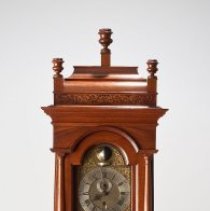Object Record
Images

Metadata
Catalog Number |
58.63 |
Object Name |
Clock |
Title |
Tall Case Clock |
Artist |
Duffield, Edward |
Place of Origin |
Philadelphia, Pennsylvania, United States |
Date |
ca. 1750 |
Description |
Mahogany tall-case (Grandmother) clock with highly decorated case and dial top. The movement contains four arbors in the time train of movement and recoil escapement. A circle for the days of the month runs in three grooved wheels behind the dial and a wooden pendulum rod (not original) is driven by a crutch wire. The case has a bell-top hood surmounted with wood finials, spool-turned in form, above a delicate blind-carved frieze of acanthus molding. This molding and a stepped cyma-molded cornice are over a bold extrados molding which encloses a column-cornered domical glazed face-door. Clock dial is inscribed "Edwd. Duffield, Philadelphia," and has gilt scrollwork spandrels, each of which has a profile wearing a feathered headdress. Black enameled Roman and Arabic numerals are in hour and minute rings respectively, and there is a sunk seconds dial above a keyhole and a date register. At the top of the dial is a lunette with moon sphere in silver and black with a short cylinder which shows the number of days of the age of the moon. The waisted case beneath has a molded trunk-door with a domical top. The base is plain molded and raised on shallow bracket feet. The door has silver plaques noting the provenance of clock. (Murphy D. Smith, "Due Reverence," 1992). |
Label |
Benjamin Franklin probably commissioned this clock, called a grandmother clock for its slightly smaller size. After his death in 1790, two clocks were listed in the inventory of his possessions. This was presumably the “Time piece in the Library,” then valued at 7 pounds 10 pence. Edward Duffield, a famous Philadelphia clockmaker, close friend of Franklin's, and executor of his will, constructed the timepiece. Duffield installed the first public clock in Philadelphia outside his store on the northwest corner of Second and Arch Streets. According to legend, Franklin suggested the idea to Duffield because he was tired of workers constantly asking him and other gentlemen for the time from their pocket watches (then expensive accessories that only the well-to-do could afford). Duffield was also responsible for maintaining the town clock at the State House (now Independence Hall). While Duffield designed clock mechanisms and sold tall-case clocks such as this one in his store, he commissioned the cases from the best cabinetmakers in the city. According to the silver door plaques, the clock passed from Franklin to his grandson Benjamin Franklin Bache (died 1798), and then to Bache's son Hartman (died 1872). Hartman's son Richard Meade Bache inherited the clock after his father's death. Upon his death in 1907, the clock passed to his son Rene Bache. The clock left the Franklin family in 1933, when banker J. P. "Jack" Morgan Jr., son of famous financier J. P. Morgan, purchased it after Rene's death. His own sons, Junius S. and Henry S. Morgan, inherited the clock in 1943. The Morgan brothers donated the clock to the APS in November 1954. |
Material |
Walnut, mahogany, oak, brass, glass, and silver |
Dimensions |
H-82.5 W-16 D-9.5 inches |
Credit line |
American Philosophical Society. Gift of Junius Spencer Morgan and Henry Sturges Morgan, 1954. |
Search Terms |
18th century eighteenth century Philadelphia timepiece Founding Father |
